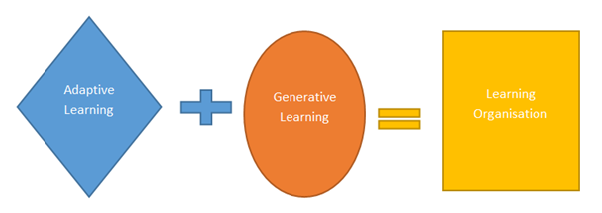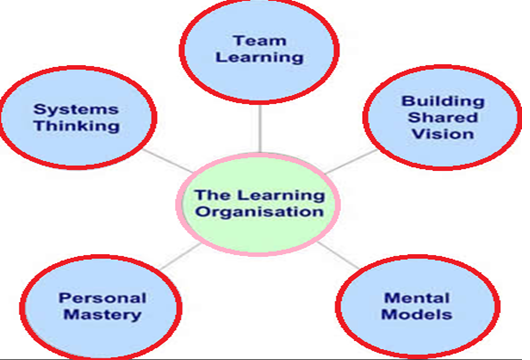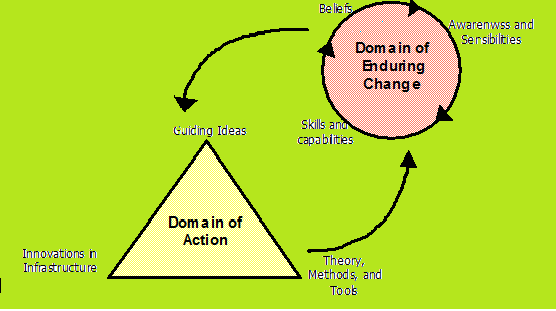Organizational theory and design: Learning organization (Organisational Behaviour and Design)
The Learning Organisation is widespread viewpoint in contemporary companies. A learning organization has potential to change its behaviours and mentality as a result of experience. An organisation learns and encourages learning among its people. It promotes interchange of information between employees hence creating a more educated workforce. This produces a very flexible organisation where people will accept and adapt to new ideas and changes through a shared vision. But many organizations do not accept certain truths or facts and repeat dysfunctional behaviours over and again. Basically, a learning organization facilitates the learning of its members and continuously transforms itself. Learning organizations develop as a result of the pressures facing contemporary organizations and allows them to stay competitive in the business environment. This concept was evolved by research of Peter Senge and his colleagues.
In current business environment, scholars, management experts put emphasis on organisational learning because there is rapid technology change. Characteristically, work has been thought of as being conservative and difficult to change. Learning was something separated from work and invention was seen as the necessary but disorderly way to change. Companies which are able to quickly learn and then modernize their work are able to change their work practices to perform better in the constantly changing environment. Change is now an important notion as compared to the past. Business re-engineering used to concentrate on eliminating waste and not on working smarter and learning. Learning organizations are not simply the most fashionable or current management trend, they can offer work environments that are open to creative thought, and hold the concept that solutions to ongoing work related problems are available inside each and every one of us. Personnel must tap into the knowledge base, which gives us the "ability to think critically and creatively, the ability to communicate ideas and concepts, and the ability to cooperate with other human beings in the process of inquiry and action (Navran Associates Newsletter 1993).
A learning organization seeks to produce its own future; that assumes learning is an ongoing and creative process for its members and one that develops, adapts, and transforms itself in response to the needs and aspirations of people, both inside and outside itself (Navran Associates Newsletter 1993). Major aspect of the learning organization is its obligation to seeking and using feedback for development. Training is one approach of learning organization, but training as a concept is not central to the definition of a learning organization. Theorists described that learning organizations are places where people continually expand their capacity to create the results that truly desire, where new and expensive pattern of thinking are nurtured, where collective expiration is set free and where people are continually learning now to learn together (Senge, 2006).

All types of organizations, whether private and public sectors that have implemented this approach find that individual responsibility increases to a significant degree and accountability becomes clearer and stronger. Companies also find that they develop true distributed leadership as everyone is a liable agent working towards a shared vision, exploring possibilities and taking initiatives that nevertheless fit well into the overall strategic direction (Maguire and McKelvey 1999). Learning organizations accomplish this objective through a strong network of relationships and employee support. Enabling learning environments enlighten business strategy by taking advantage of distributed intelligence throughout the organization, they fully involve internal and external stakeholders by responding to issues identified by stakeholders, they change the behaviour of the organization through belief and attitude change in individuals within the organization, and lastly, they help to assimilate sustainability thinking into the culture of the organization. All human organizations are multifaceted.
There are numerous characteristics of complex learning organizations in both the private and public sectors. Organizational learning is more than individual learning and arises through the collaboration of individuals in groups and teams of different sizes. Organizational learning needs the right environment to succeed, one that allows time for reflection on past actions and outcomes and is prepared to accept some indigestible truths and one that is not a blame culture in the sense that 'mistakes' are unacceptable. Such an environment makes a distinction between 'mistakes' that are the result of irresponsibility and lack of forethought and those that are genuine explorations of a new idea or a new way of working. If individuals and teams are inspired to be inventive then they need to discover alternatives and to take thoughtful risks. But not all the experiments will thrive.
Senge (1994) defines the core of learning organization work based on five "learning disciplines that include systems thinking, personal mastery, mental models, shared vision and team learning.
Personal Mastery: Learning to expand personal capacity to creating the results people most desire, and creating an organizational environment which encourages all its members to develop themselves toward the goals and purposes they choose.
Mental Models: Reflecting upon, continually clarifying, and improving our internal pictures of the world, and seeing how they shape our actions and decisions.
Shared Vision: Building a sense of commitment in a group, by developing shared images of the future we seek to create, and the principles and guiding practices by which we hope to get there.
Team Learning: Changing conversational and collective thinking skills, so that groups of people can reliably develop intelligence and ability greater than the sum of individual members' talents.

Systems thinking: It is type of thinking and a language to explain and understand the forces and the interrelationships that shape the behaviour of systems. This discipline helps to see how to change systems more efficiently, and to act more in tune with the larger processes of the natural and economic world.
Senge considers that "the learning organization exists primarily as a vision in our collective experience and imagination" (1994). He also believes that there is a great impact of practices, principles on the performance of organization. Practices are "what you do". Principles are "guiding ideas and insights," and essence is "the state of being those with high levels of mastery in the discipline" (Senge, 1990). He looks at leaders as teachers, stewards and designers a different metaphor than conventional business practices in earlier time. It is the leaders who must pave the way to the creation of the learning organization, and they must also model the process. Theoretical studies demonstrated that within the learning organization a sense of trust and safety are developed and the members reveal uncertainties and make and acknowledge mistakes. This cycle provides a "domain of enduring change" within the organization. The style of a learning organization is considered a "domain of action" and consists of guiding ideas, innovations in infrastructure, theory, methods and tools. The main ideas include the vision, values and purpose of the organization. They have logical depth and are seen as ongoing. They include the viewpoint of the whole, the community nature of the self and the generative power of language. The development of tools and methods test these theories and cause them to be shaped and refined, and bring about the cyclical nature of this domain of action. These changes create infrastructure innovations and "enable people to develop capabilities like systems thinking and collaborative inquiry within the context of their jobs" (1994).
Senge principles (1994)

Michael has described that the "term learning organization is the label now being used for an integration of a set of ideas that have emerged from organizational research and practice over the past three or four decades on ways of organizing work in such a way that the often-conflicting demands of organizational effectiveness and individual job satisfaction are simultaneously met. The learning organization is, in many ways, a natural evolution of older participatory management themes of the 1970's and more recent emphasis on empowerment and self-managed work-teams. A learning organization is not so much characterized by its altered structure (flatter and less hierarchal) and redesign of work (emphasis on teams), but by the transformation of the relationship of the organization to the individual and increased capacity for adaptation and change. The previous overriding concern for control (e.g. motivate others, organize work for others, set goals for others, etc.) is replaced by a concern for learning by all organizational members on behalf of the organization. Learning about technical things and things about the external environment is greatly valued, as are learning things about it including its organizational processes. A learning organization expects its members "to act as learning agents for the organization, responding to changes in the internal and external environment of the organization by detecting and correcting errors in organizational theory-in-use, and embedding the results of their inquiry in private images and shared maps of organization" (Argyris & Schon, 1979, p. 29).
Main activities of a learning organization are as follows:
- Systematic problem solving: Thinking with systems theory; insisting on data rather than assumptions; using statistical tools.
- Experimentation with new approaches: Ensure steady flow of new ideas; incentives for risk taking; demonstration projects.
- Learning from their own experiences and past history: Recognition of the value of productive failure instead of unproductive success.
- Learning from the experiences and best practices of others: Enthusiastic borrowing.
- Transferring knowledge quickly and efficiently throughout the organization: Reports, tours, personnel rotation programs, training programs.
Main Benefits of learning organizations include maintaining levels of innovation and remaining competitive[, being better placed to respond to external pressures, having the knowledge to better link resources to customer needs, improving quality of outputs at all levels, improving Corporate image by becoming more people oriented, increasing the pace of change within the organization. A learning organization provides good source of information to employees needed to enable a company to cope with the loss of main staff and continually change itself. When more than one person knows the critical aspects of an operation, the loss of a staff member becomes less disruptive.
Learning organizations also improves employee morale, improving performance, recruitment and retention. Research has revealed that learning organizations give companies a competitive advantage.
Academic literature, there are some criticisms of the learning organization principles. Megan Santosus mentioned the difficulties to develop a learning organization. Learning initiatives often require sweeping changes throughout the organization. Matthias Finger and Silvia Burgin Brand defined some of the limitations of the learning organization philosophies. They concluded that it is not possible to change a bureaucratic organization by learning initiatives alone. They considered that by referring to the conception of the learning organization it was possible to make change less threatening and more acceptable to participants. They debated that concept of the learning organization focuses mainly on the cultural dimension and favours individual and collective learning processes at all levels of the organization, but does not connect them properly to the organization's strategic objectives.
To sum up, Learning organizations are characterized by total employee engrossment in a process of collaboratively conducted, collectively accountable change directed towards shared values or principles. Theorists emphasized that most conceptualizations of the learning organizations seem to work on the assumption that 'learning is valuable, continuous, and most effective when shared and that every experience is an opportunity to learn' (Kerka 1995). Learning organizations are adaptive to their external environment, continually enhance their capability to change/adapt, develop collective as well as individual learning and use the results of learning to achieve better results. Learning organizations work because people are appreciated for their own skills, values and work. All opinions are treated similarly and with respect. By being aware of their role and importance in the whole organisation, the employees are more inspired to do work. This encourages imagination, hence leading to novel solutions to problems. It leads to job satisfaction. Leaning organization has importance in business environment because People learn skills and acquire knowledge beyond their specific job requirements. This allows them to appreciate or perform other roles and tasks. Flexibility allows labours to move freely within the organisation, although it removes the barriers associated with a rigidly structured company. It also guarantees that any individual can cope rapidly with a changing environment.

